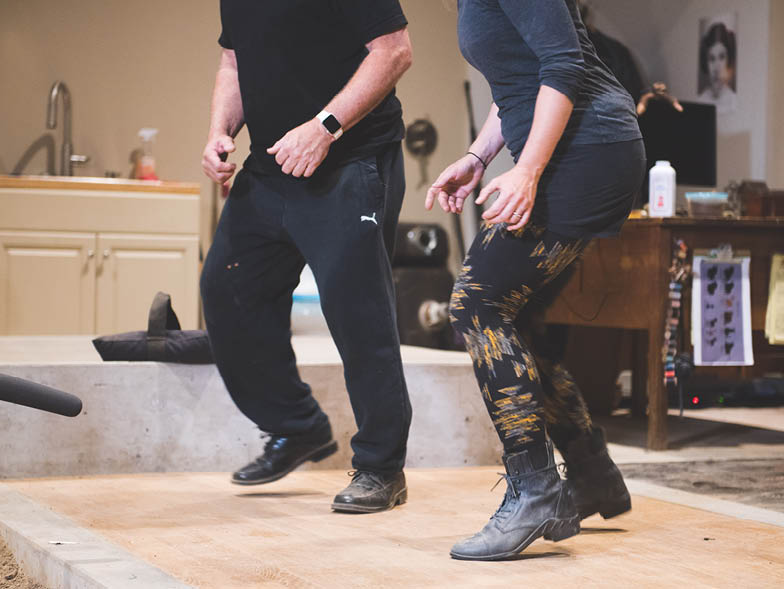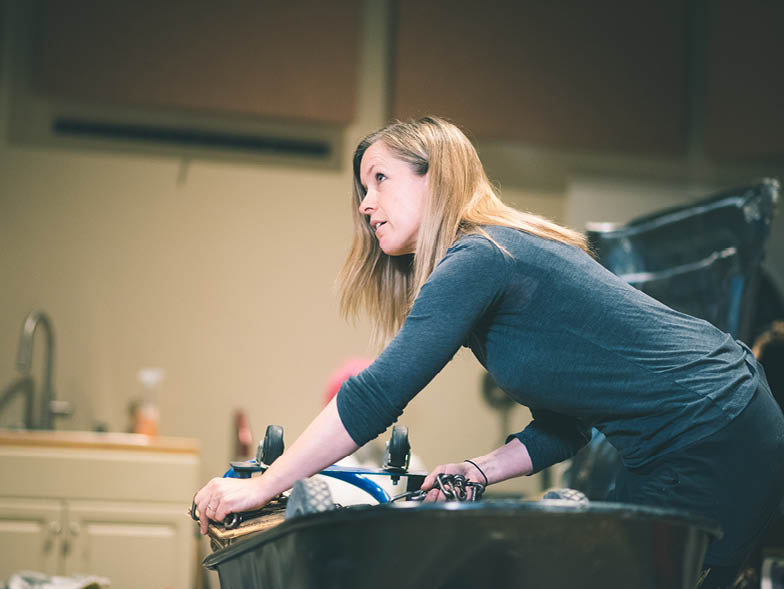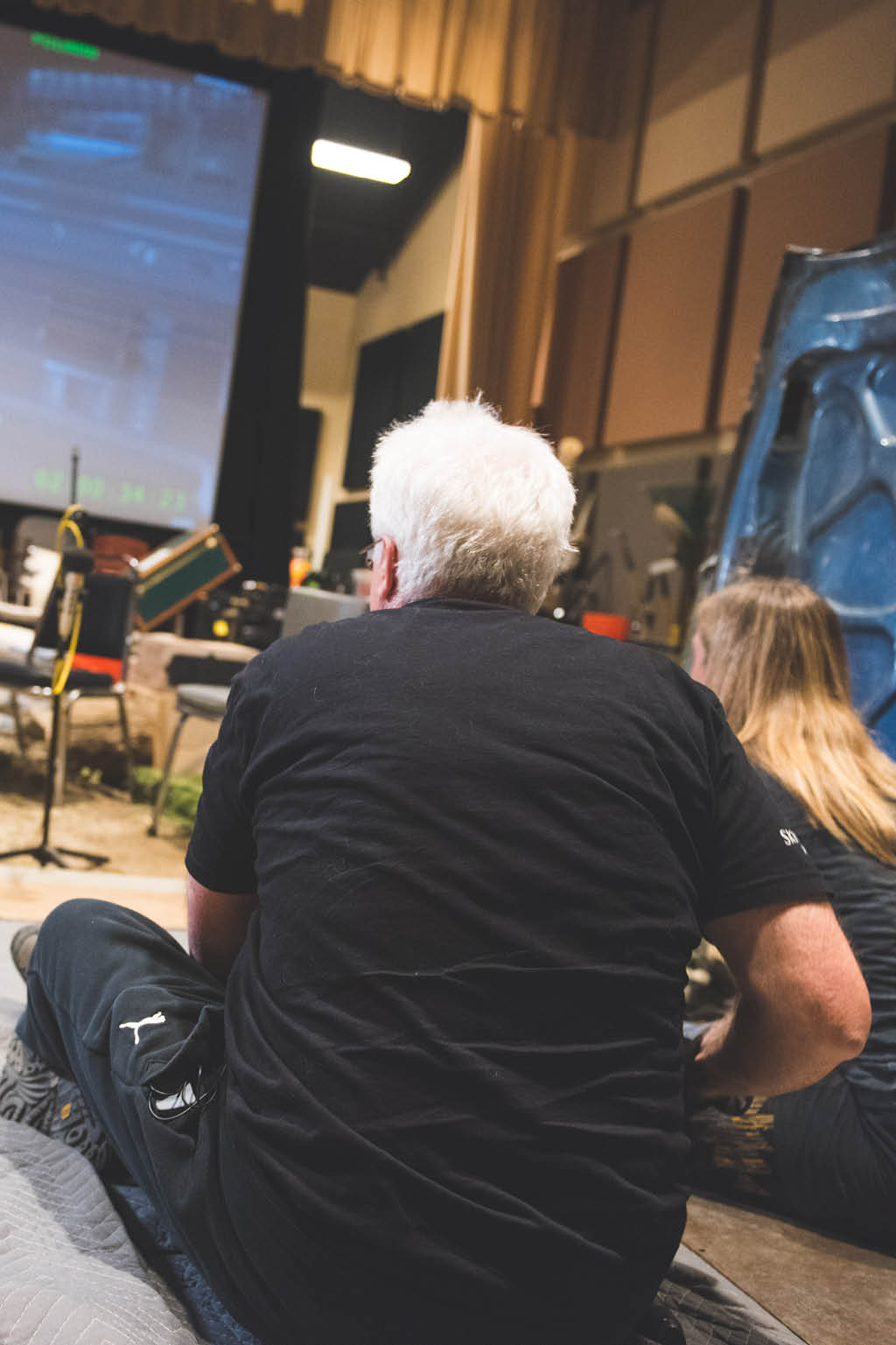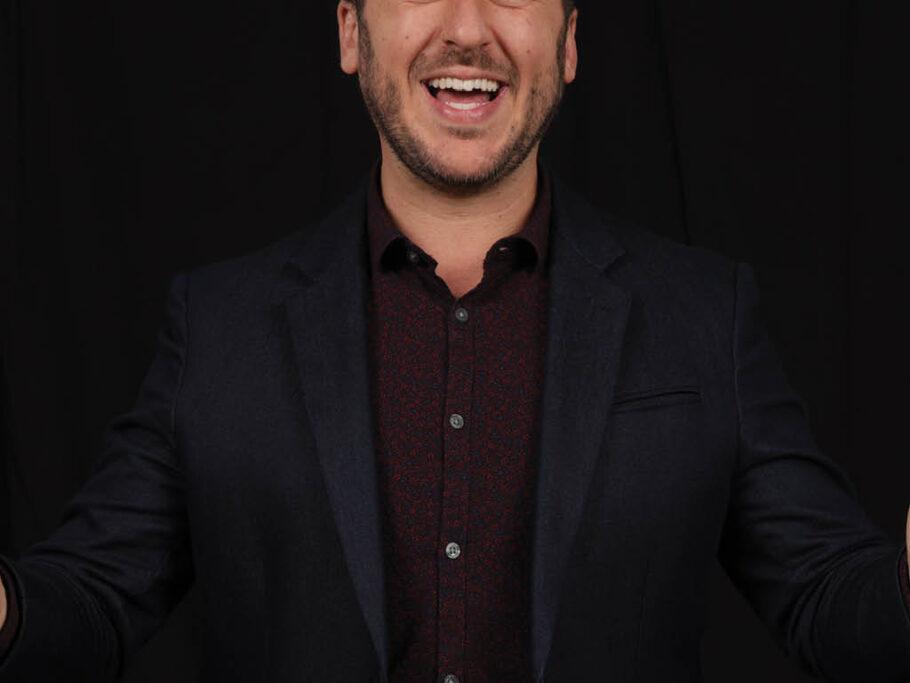Movie Magic: The Foley Team of Skywalker Sound
You can’t make a Hollywood blockbuster, a TV episode, or a video game without the Foley team, which creates the many subtle sound effects such as footsteps. With over 850 credits between them, Skywalker Sound’s Archives Foley team—artists John Roesch and Shelley Roden, and mixer Scott Curtis—is one of the world’s leading producers of this cinematic craft.
How did you get started in the entertainment industry?
JOHN: I made a film at New York University, which opened doors to the American Film Institute. Serendipitously, somebody there asked for my help with Foley sounds. I kept getting asked to do more Foley, and here I am, thirty-nine years later.
SCOTT: I have a music background. I went to San Francisco State for broadcasting and moved to LA after graduation. I eventually found myself on a Foley stage, and I realized that my recording experience could apply to sound effects, so I started mixing and editing.
SHELLEY: I was a cinema-and-photography major at Ithaca College. Through its LA program, I secured an internship at an independent postproduction sound house in Hollywood. When I began performing Foley for several student film projects, a sound supervisor friend encouraged me to pursue it as a career.
Since you knew one another from a previous company, did the team gel quickly?
SCOTT: Foley can be very subjective. So there was a bit of a process in the beginning trying to figure out each other’s sensibilities.
JOHN: My methodology previous to Scott was a little different, so he and I needed to fit together. In fact, I like his methodology even more than what I had been doing!
SHELLEY: We had worked with one another at different facilities; however, this was the first time we were a team. We quickly established a trust and a means of communication. Over time, our shared respect and focus evolved into a creative and fun environment of exploration and discovery.

What makes your custom Foley stage special?
JOHN: I designed it with the help of some key people: a partner from many years ago, people at Skywalker, and Foley artist friends. As far as I know, it is probably one of the better stages in the world. It contains some elements that hadn’t been previously engineered together on another stage because Foley artists designed it. For example, the water tank area is set up so we have a large tank, a smaller one, and then a ramp off of that that allows us to dam up the water so we can go from a little bit to a splashy area.
SHELLEY: Multiple room mics give Scott options based on where John and I are working in the room. We can also open up a large elephant door to the outside so we can bring in vehicles or, as we did for Dunkirk, bring in an aluminum boat to dunk into the large water tank.
What is your process for starting a project?
JOHN: We try to collectively watch either the first reel or the entire show, hopefully with the supervising sound editor. Then cue sheets—the road maps from point A to point B—are created and broken down into groups: footsteps, props, and, potentially, separate movements.
Shelley and I will look at the footstep cue sheets to determine sounds. For example, for Doctor Strange, Shelley and I each tested two sets of boots for Doctor Strange and then decided which boots we’d use. Once we decided this for each character, we divvied them up.
For props, Shelley will typically decide what she’s going to do and what I’ll do. If there’s a unique movement, such as Doctor Strange’s cape, there will be a separate channel just for that. We tend to play to our strengths, but it changes project by project. Ultimately, we want to give Scott the ability to have discretion for what he wants to do sonically.
What is more important: getting the perfect sound effect or the perfect timing?
JOHN: Sound effect. With good sound effect, the timing will be perfect. Vis-à-vis, if I do something and it is two frames early or late but is the perfect sound, Scott can easily nudge it. But if the sound is just OK, that is the way it is going to stay.
SCOTT: They often want me to do one more take to get the sync better. But I’ll stop them because I know that the performance was perfect.
What are some interesting props you use to create sounds?
JOHN: When you see a sword swinging, or ”jinging,” as we call it, it’s usually a machete because machetes have a sound that people associate with swords. If someone breaks a bone, we might use a snap pea, a piece of celery, or a lasagna noodle. Also, when we do horses galloping, we don’t use coconuts; we use plungers without the wooden dowels.
SHELLEY: For Kong: Skull Island, there’s a moment when Kong uproots a pine tree and runs his free hand down the trunk, tearing all the branches off. To achieve that texture, I used a rake and a pinecone. Scott simultaneously manipulated that source material as I was performing it to help make it sound gigantic.
Scott, are any particular effects more difficult to pick up on the mic than the others?
SCOTT: It really depends. Based on how I am hearing the sounds through the mic, I will give direction notes. In that Kong scene, I needed to hear more of the rake versus the pinecone. So I give those directions to John and Shelley, they adjust accordingly, and we try it again. We’ll keep tweaking it until we’re all happy.
You do work on movies, TV shows, commercials, and video games. Are there differences in those mediums?
SCOTT: With video games, we’re covering the cut scenes, which are like mini movies: animated scenes that take place between the game action itself. We have to add everything but the production dialogue. Creating assets for the in-game material, such as combat boots on cement, is unique to video games as well. We have to do the movements—brisk walking, running, jumping, pivots, and so on. They get added to their in-game audio engine, so when you are walking around in the game, the engine triggers them to approximate your walking sounds.
SHELLEY: We usually have more time to dig deep into the story, the characters, and the action on movies than we do on television shows. Television shows demand precision and quick decisions. Films allow us to add subtle nuances or sweeteners and experiment with new ideas. Video games can be cinematic, and they can also be physically demanding, which can be fun for us athletic types.
How has Foley changed over the years?
JOHN: The biggest change is obviously technology. Besides that, in the early days, you would generally divide the film into sections, so there wasn’t the continuity you have today. But the actual creation of sounds and recording them has not changed at all.
The nature of what needs to be captured has changed, though, because digital technology allows the supervisor sound editors to do things that we might not be able to do on the Foley stage. For example, in the ‘80s, we would Foley everything, from soup to nuts. Back to the Future is one example of that. The film’s entire opening sequence—the motors, the Rube Goldberg machine, the dog food can—was Foley, except for the ticktocks in the background. This might be done differently today.
SHELLEY: Soundtracks are becoming denser, so we have to keep in mind what part of the sonic spectrum is available in any given moment. A Foley sound effect that appears to be perfect when played solo may lose its intended effect when you add dialogue, hard effects, and music. We are also seeing more and more visual effects than ever, and any world that is animated needs accompanying sounds to make it come alive—so that is more work for us, which is great.
Were any projects especially challenging?
JOHN: The Abyss was extremely difficult because it took place mostly underwater. Also, John Carter had various tribes with different armors and trying to get the sounds in shared scenes was very difficult because they were all in the same frequency. Lastly, Schindler’s List was one of the most difficult films I have ever worked on because of the actual content. It is an amazing picture, and I am very proud to have worked on it.
SHELLEY: The first film we worked on together was Alice Through the Looking Glass. This was also the first time human footsteps had ever been done on our new Foley stage. It was a challenge because we did not yet know the sweet spots in the room, how our shoes would play, or the level of grit we needed for each surface. Navigating our way through that experience together helped us to bond as a team.
This job requires a good ear. How important is the sense of touch?
JOHN: It is vital, certainly from a performance standpoint for the props and then, by extension, through the feet. By far, the hardest thing to do correctly in a film is footsteps, and that is all touch.
SHELLEY: As with any instrument, there are various sounds you can create with any object and with your feet. Over time, a Foley artist develops a sense of how to manipulate the selected shoe, surface texture, prop tools, and resonance. This involves both sensitivity with touch and critical listening.
What is the most satisfying part of your job?
JOHN: Playing back a finished reel for others is very satisfying, as is going to the screening after everything is completed. To see how everything fits together is a wonderful experience because we are a very small part of a very large puzzle. This is indeed the best job in the world.
SHELLEY: Every day, we are tasked with hundreds of opportunities to create effective sonic moments within the context of a story. Selecting the right prop or shoe and performing in such a way to make the sounds fit seamlessly into the rest of the soundtrack is very satisfying.
SCOTT: For me, it is the process of building the tracks: of envisioning how I know this thing ultimately is going to sound and actually building those pieces. When it works and we can build on it, I am happy.

As a Foley team, what does your art add to your projects?
JOHN: It brings a reality that helps push
a storyline forward and upholds the believability of what you are seeing. We don’t want to do anything that takes you out of the moment or is not truthful. If we’ve done our job right, you don’t know we’ve done it. In a sense, we are the unsung artists in sound.
SCOTT: The purpose of Foley is to fill in gaps with realistic sound effects so there aren’t lulls in the production track. That way, the audience can focus on the dialogue and the story while still following the action. We help keep things real.
SHELLEY: Foley not only completes the soundtrack by adding complex detail, such as the various notes of debris dancing over a car as it crashes, but also can emphasize a comical moment or add a subtle feeling of texture to a dramatic moment.
JOHN: It’s a unique role, that’s for sure. There are more astronauts in the world than there are professional Foley artists.
SCOTT: And there are half as many Foley mixers as there are Foley artists. So we are really rare.
SHELLEY: And having a crew of people who can count on each other and laugh at each other, as we can, is the best part of being on this Foley team.
For more info, visit www.skysound.com
























